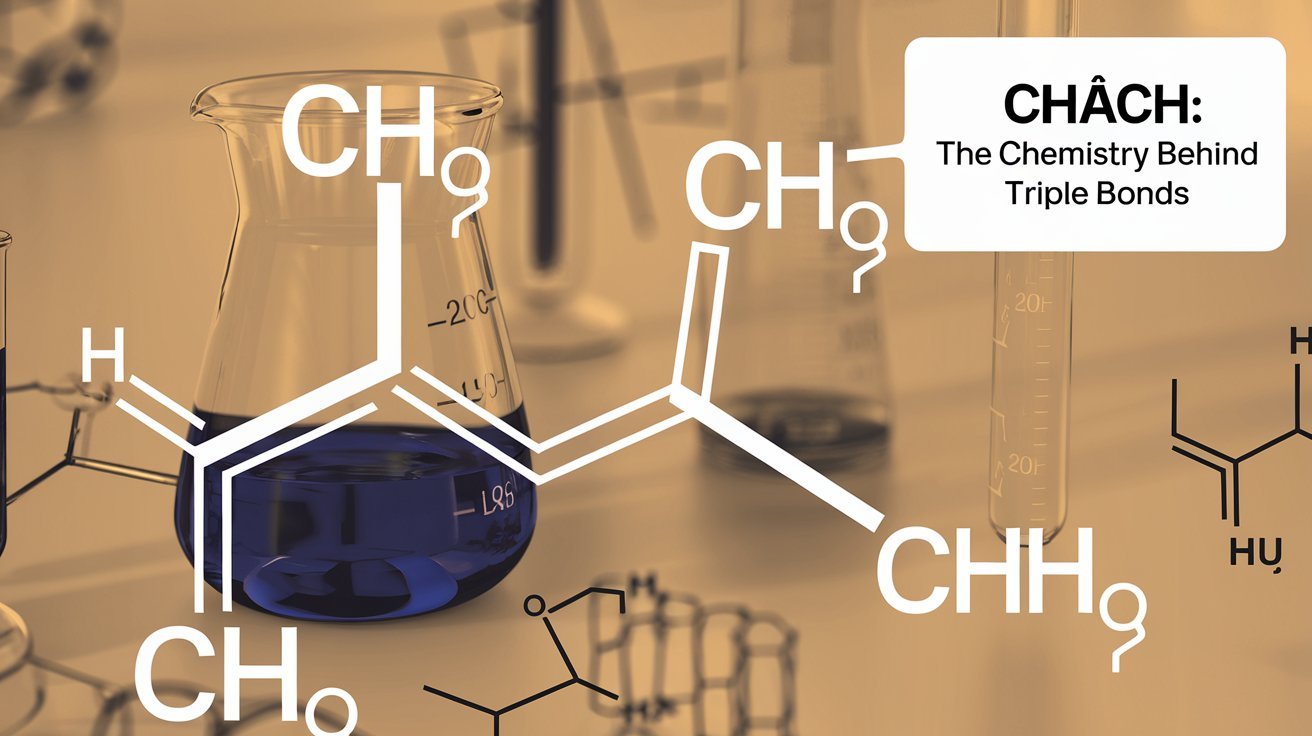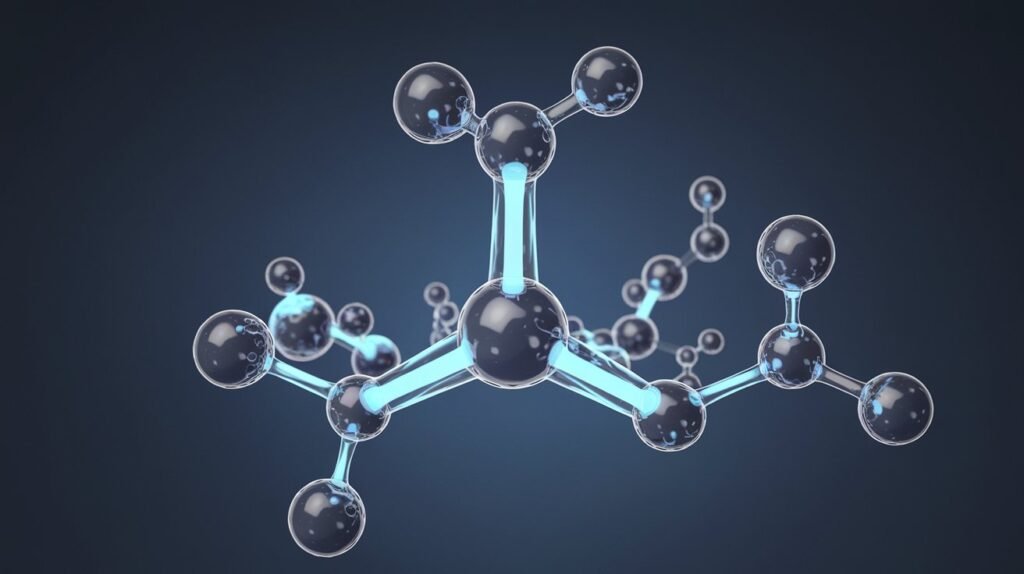Understanding CH≡CH: The Chemistry Behind Triple Bonds

CH≡CH, also known as an alkyne, is a type of chemical compound where two carbon atoms are connected by a triple bond. This simple yet unique structure plays a key role in many chemical reactions, making it important in fields like organic chemistry and industrial processes. When you see the “≡” symbol, it tells you that there are three bonds between the two carbon atoms, which makes CH≡CH quite different from other compounds like alkanes or alkenes.
The properties of CH≡CH are interesting because of the strength of the triple bond. This makes it more reactive than some other types of compounds. When chemists work with CH≡CH, they can create a variety of new substances, which is why it’s widely used in chemical synthesis and the production of plastics, fuels, and even medicines.
Table of Contents
What is CH≡CH? Understanding the Triple Bond Chemistry
CH≡CH is a type of molecule known as an alkyne. It’s made up of two carbon atoms that are connected by a special kind of bond called a triple bond. A triple bond is stronger and different from single or double bonds, which you might already know about. It’s represented by the symbol “≡” between the carbon atoms.
In CH≡CH, the triple bond means there are three shared electrons between the two carbon atoms. This bond is really strong, making this compound different from others, like alkenes or alkanes, that only have single or double bonds. The presence of this bond makes CH≡CH highly reactive and capable of forming many different compounds in chemistry.
The “≡” symbol in CH≡CH shows that the bond between the carbon atoms is special. Unlike regular bonds, this one is formed by the sharing of six electrons instead of just two. This is what makes CH≡CH behave differently in chemical reactions compared to simpler compounds. Chemists use this compound to create various chemicals used in everyday life.
The Significance of CH≡CH in Organic Chemistry: Why It Matters
CH≡CH is incredibly important in organic chemistry. Organic chemistry deals with the study of carbon-containing compounds, and CH≡CH is one of the basic building blocks in this area. The way CH≡CH reacts with other chemicals can help scientists make all sorts of new substances.
Many things we use today, like plastics, synthetic materials, and medicines, are created with the help of CH≡CH. This compound’s special triple bond allows it to bond with other chemicals in unique ways, making it useful for creating a wide range of products.
This compound also has a big role in the creation of pharmaceuticals. Chemists use it to develop drugs that help treat various diseases. The unique properties of CH≡CH make it a key player in both everyday items and important life-saving medications.
CH≡CH vs. Other Chemical Bonds: How the Triple Bond Stands Out
When comparing CH≡CH to other chemical bonds, like those found in alkenes or alkanes, it stands out because of its triple bond. This triple bond gives CH≡CH stronger properties and makes it more reactive. Alkanes, for example, only have single bonds, which means they are less reactive than CH≡CH.
In alkenes, there is a double bond between the carbon atoms, making them more reactive than alkanes but not as reactive as CH≡CH. The triple bond in CH≡CH gives it the ability to form bonds with other elements more easily, making it a powerful tool for chemical reactions.
- Single Bonds (Alkanes): Weaker and less reactive.
- Double Bonds (Alkenes): Stronger than single bonds but not as reactive as triple bonds.
- Triple Bonds (CH≡CH): The strongest and most reactive of the three, allowing for complex chemical reactions.
How Does CH≡CH React? A Look into its Unique Reactions
CH≡CH is highly reactive due to its triple bond. This means it can undergo various chemical reactions that other compounds with single or double bonds might not. One of the most common reactions it undergoes is addition reactions. In these reactions, CH≡CH reacts with other compounds like hydrogen, halogens, or water, breaking the triple bond and forming new products.
For example, when CH≡CH reacts with hydrogen, it forms an alkane, which is a different type of compound. This reaction is important because it helps create hydrogenated oils, which are used in many food products. The ability of CH≡CH to break apart its triple bond and combine with other atoms makes it very useful in creating new materials.
From Plastic to Medicine: How CH≡CH is Used in Everyday Life
CH≡CH plays a huge role in the world of industrial chemistry. One of its most important uses is in the production of plastics. The compound’s ability to react with other substances makes it a valuable starting material for making various types of plastic, which we see in everything from bottles to packaging.
Another important use of CH≡CH is in medicine. This compound is involved in creating synthetic drugs, including those used in cancer treatment. Its role in pharmaceutical chemistry is essential, as it helps form the structure of many drugs that are crucial for modern healthcare.
- Plastic Production: Used to make various types of plastics and materials.
- Medicinal Chemistry: Involved in creating synthetic drugs, including life-saving treatments.
The Role of CH≡CH in Industrial Chemistry: Key Applications You Should Know
CH≡CH is not just important in the lab, but also in the world of industrial chemistry. Industries use it to create a variety of products that make our daily lives easier. For instance, CH≡CH is involved in making synthetic rubber, a material found in tires and many other everyday items.
Another key application of CH≡CH is in the production of acetylene, a gas that is used in welding and cutting metals. This shows how CH≡CH plays a role not just in chemical reactions, but also in industries that help build and shape our world.
Key Applications of CH≡CH in Industry:
- Synthetic Rubber: Used in products like tires and footwear.
- Acetylene Production: Important for metalworking and welding.
Is CH≡CH Dangerous? Exploring the Safety of Triple Bond Compounds

CH≡CH, like many chemical compounds, needs to be handled with care. Because of its strong triple bond, it can be reactive, which means it can react with other substances, sometimes dangerously. This is why it’s important for scientists and industries to take special precautions when working with CH≡CH.
In its pure form, CH≡CH can be flammable and can cause harm if not stored properly. However, when used safely and under controlled conditions, it can be very useful in making other products. Proper training and safety equipment are essential to avoid accidents in environments where CH≡CH is handled.
- Flammability: CH≡CH is highly flammable, so it must be handled in well-ventilated areas.
- Proper Storage: Always store it in sealed containers and away from heat sources.
- Protective Equipment: Use gloves and goggles when working with it to avoid direct contact.
How to Identify CH≡CH in Chemical Structures: A Beginner’s Guide
Identifying CH≡CH in chemical structures is easier once you know the signs to look for. The first thing to notice is the triple bond symbol “≡” between two carbon atoms. In a structural diagram, this triple bond is shown by three lines connecting the two carbon atoms.
When you see this structure in a molecular diagram, it tells you that the compound is an alkyne, specifically CH≡CH. The simplicity of this structure makes it easy to spot, even for beginners. It’s important to note that other compounds like alkenes will have double bonds, so keep an eye out for the number of lines between carbon atoms.
Tips for Identifying CH≡CH in Structures:
- Look for a Triple Bond (≡): This indicates an alkyne.
- Carbon Backbone: Two carbon atoms connected by the triple bond.
- Single or Double Bonds: Don’t confuse it with alkenes (double bond) or alkanes (single bond).
Learning CH≡CH: Why Triple Bonds are So Important in Chemical Reactions
Triple bonds, like the one found in CH≡CH, are important because they make reactions faster and more exciting. In chemical reactions, CH≡CH can easily break its triple bond to form new products. This makes it highly valuable in organic chemistry, where complex reactions are needed to make different compounds.
Because of its reactive nature, CH≡CH is often used as a starting point in the creation of many important substances. The energy from the triple bond helps these reactions to proceed quickly, which is why it’s so useful in labs and industries around the world.
- Quick Reactions: The triple bond in CH≡CH makes chemical reactions faster.
- Creating New Compounds: CH≡CH is used to make many products, from plastics to medicines.
- Importance in Research: Scientists use CH≡CH to discover new chemical reactions and create useful materials.
Conclusion:
In conclusion, CH≡CH is a special molecule with a strong triple bond that plays a big role in chemistry. Its reactivity and ability to form new compounds make it very useful in many industries, from medicine to plastic production. While it’s a powerful tool for creating new substances, it’s also important to handle CH≡CH safely due to its flammability and reactivity.
Understanding CH≡CH helps us see how chemistry is everywhere in our daily lives. From the plastic bottles we use to the medicines we take, CH≡CH is involved in many things. With new discoveries and safer methods, its role in helping us create better products will only grow.
FAQs:
Q: What is CH≡CH?
A: CH≡CH is a chemical compound known as an alkyne. It has a strong triple bond between two carbon atoms.
Q: Why is CH≡CH so important in chemistry?
A: CH≡CH is important because it is highly reactive and can form many different compounds used in plastics, medicines, and more.
Q: Is CH≡CH dangerous?
A: Yes, CH≡CH can be dangerous because it is flammable and reactive, so it needs to be handled carefully.
Q: Where is CH≡CH used?
A: CH≡CH is used in making plastics, synthetic rubber, acetylene gas, and even some medicines.
Q: How can I recognize CH≡CH in chemical structures?
A: CH≡CH can be recognized by the triple bond symbol (≡) between two carbon atoms in a chemical structure.




